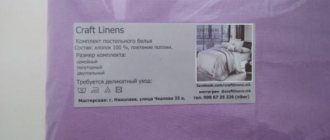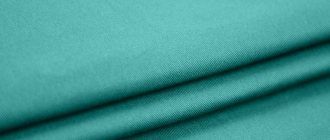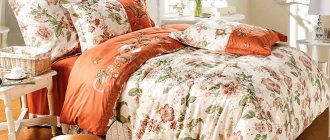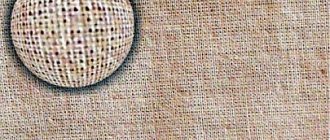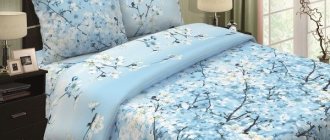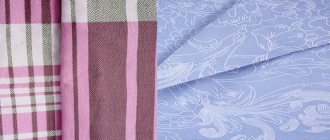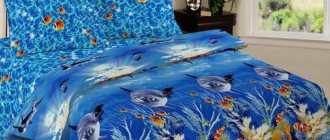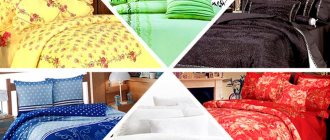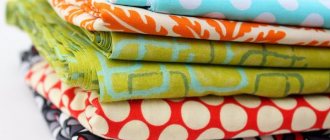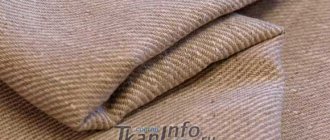- Naturalness and quality
Beautiful and practical bed linen brings aesthetic pleasure, gives a pleasant feeling, and allows you to get a good night's sleep. First of all, linen made from natural materials – cotton, linen, silk – has these advantages. If you decide to buy or sew new sheets and pillowcases, then our article will help you figure out which fabric is best for bed linen.
Beautiful bedding brings aesthetic pleasure, gives a pleasant feeling and allows you to get a good night's sleep.
Natural fabrics vary in density, texture, method of weaving threads and many other parameters. Undoubtedly, natural silk and linen have many advantages, but not every one of them is an advantage when sewing bed linen. Silk is too expensive, cold and “slippery”, and linen is quite rough and does not iron well. Therefore, the most popular and in demand material is cotton. Different types of fabrics are produced from it: purely natural or mixed (with an admixture of synthetics), dense and thin, smooth and rough. All that remains is to choose which fabric is best for bed linen.
The main advantages of natural fabrics are that they are highly breathable and absorb moisture, do not become electrified and do not cause allergic reactions.
What is the difference between poplin and satin: advantages
Poplin or satin - which is better?
What made these materials so popular? Why do people pay attention to them and when should you choose one over the other? In addition, we will tell you how to properly care for textiles so that you can enjoy them for a long time.
Satin and poplin have many excellent characteristics:
- Large selection of colors and patterns
- Both fabrics retain heat well and absorb moisture
- They allow air to pass through well and allow the body to breathe.
- High strength and durability
- Fabrics are environmentally friendly
- Hypoallergenic, which means they can be used by allergy sufferers
- Retains its shape and does not lose it after several washes
- Coils don't appear on them
- Fabric doesn't shrink
- They stand up well to multiple washes and don’t even need to be ironed.
It is worth noting that both fabrics are made from cotton and they are not the only ones used for sewing bed linen. If we take into account the hypoallergenic characteristics, then calico is also suitable here.
To make the right choice in favor of certain characteristics, you need to understand how these fabrics differ and which one is better.
Basic criteria for choosing fabric
What criteria do you consider priority when choosing bed linen? What do you lean towards - spectacular appearance or daily comfort, price or quality?
We spend a third of our lives sleeping, so choosing the right bedding is fundamentally important.
Naturalness and quality
All types of fabric discussed above, namely calico, satin, poplin and percale, are natural cotton environmentally friendly materials. They have valuable qualities: they allow air to pass through, absorb moisture, relieve static tension, do not provoke the proliferation of pathogenic bacteria, and do not cause allergies. The natural properties of cotton provide the necessary comfort and hygiene of linen, which makes it a safe and versatile solution for everyday use.
Before buying a ready-made set or fabric for sewing bed linen, be sure to read the label indicating the composition of the fabric
Which fabric is best for bed linen? Natural, of course. Although small admixtures of artificial materials even bring some benefits: they increase wear resistance, reduce creasing, and provide elasticity. But if the composition contains more than 75% synthetics, the fabric stops allowing air to pass through, creating a “greenhouse effect” in the bed and accumulating static electricity.
Now many manufacturers are reducing the cost of traditionally natural fabrics by adding synthetic fibers: polyester, nylon, viscose, microfiber, spandex, etc.
Care
According to this indicator, the best choice is poplin or satin, which wash well at low temperatures (30-40 ℃) and do not require careful ironing.
Ironing provides additional disinfection of bed linen
Calico and percale must be ironed to give these fabrics softness and smoothness. It is recommended to wash calico without bright printed patterns at a temperature of 40-60 ℃ and iron it with a hot iron before it has had time to dry completely.
Appearance and price
Satin and percale are considered the most aesthetic and “rich”, as they have a smooth surface texture with a noble shine. This directly affects their price, which can significantly exceed the cost of similar-sized calico sets. In terms of the ratio of appearance and cost of fabric, poplin is the optimal choice for many.
In any case, it is up to you to decide which fabric is best for bed linen. We hope that our article will help you make your choice.
Satin - what kind of fabric: review, characteristics
Satin
Satin is a material that has an elegant appearance. It first appeared in the Middle Ages in China. It was there that they first used a unique satin weave - twisted fibers that make the product bright and shiny. Silk was originally used, but today most linen is made from cotton.
Despite this, satin still remains sophisticated. Double weaving of threads allows you to preserve the beauty of the fabric, and natural cotton ensures hygroscopicity, and cotton is even more convenient to use than silk.
The threads are treated with a special alkali and are strong and wear-resistant. Moreover, they perceive permanent staining. Today, satin fabrics are made from different threads and differ in density.
The differences also lie in the methods used to create drawings on them.
- There is satin with a weave of 85-130 threads per square centimeter. In this case, spectacular designs are created using pigment printing. Drawings can be transferred directly from photographs, and the beautiful 3D effect will not leave anyone indifferent.
- There is another type of satin - printed. It has 170 threads per 1-2 cm. This fabric features a clear pattern that is created using reactive printing.
- Printed satin has a similar density as printed satin, but the pattern is usually smaller than the size of the canvas itself. The fabric is more expensive and this is not even surprising, because the fabric looks gorgeous and its quality is high.
- Satin jacquard has 220 threads. This fabric has more shine and, accordingly, is more durable. Beautiful designs are created by weaving rather than by applying paint. The fabric is similar in quality to printed silk, but costs less.
Satin jacquard
- Macosatin is an elite fabric and is made from Egyptian cotton. The material also has a dense weave and has a special silkiness and matte shine. Drawings are applied using reactive printing. The drawings are stable and clear.
Caring for satin is not at all difficult. The first time it is better to set the wash to no more than 40 degrees. Then you can increase the temperature to 60 degrees. Before washing clothes, it is recommended to turn them inside out. Fabric becomes very heavy in water, so do not overload the machine.
It is worth noting that ironing of satin linen is not required. If you want to iron it, leave it on the wrong side and make sure that the temperature is no more than 90 degrees.
Particular attention should be paid to jacquard fabrics. They can be washed in a machine at a temperature not exceeding 30 degrees without bleach and without spinning. The product is dried in partial shade, and you can iron it in the “silk” mode.
Caring for polysatin
In order for things to last a long time , you need to properly care for them:
- When washing in a machine, it is better to set the gentle cycle;
- set the temperature to 40 degrees. The material does not tolerate very hot water;
- use only mild gel-type detergents;
- To ensure that the material retains its brightness, it is recommended to add fabric softener when rinsing;
- Detergents with a high concentration of chemicals are not acceptable for use;
- Drying is best done at home;
- iron things made of such material only with a layer of gauze applied.
Poplin - what kind of fabric: review, characteristics
Poplin
The first poplin was created in the 14th century in France. It came to Russia only in the 18th century and is popular to this day. Initially, the material was created from silk, it was very expensive and therefore was available only to rich people.
Today's poplin is a smooth and dense fabric that is created from pure cotton or with the addition of silk, wool and other fabrics. This is what distinguishes poplin from cotton.
The main feature of poplin is its simple weaving, which is made in a very interesting way. Medieval craftsmen created canvas from different threads. Thin threads were taken as the basis, and threads 1.5-2 times thicker became transverse. This interesting technique made it possible to create a beautiful fabric with beautiful transverse ribs that are equally beautiful on both sides. Pajamas, dresses, shirts and blouses are made from poplin.
Thanks to its strength, softness and natural composition, the material is ideal for making bed linen. Often, bedding for newborns is made from this fabric.
The production technology is simple, and the threads are natural. This all provides ideal value for money. This is why the material is in demand among buyers.
It is important to note that poplin comes in several types:
- Bleached . Dazzling white fabric. This is achieved through the use of chemical reagents. The initial color of the fabric is yellow-gray. Such beautiful products can make the interior fresh and attractive.
Bleached poplin
- Printed or printed . For production, white fabric is taken, onto which a design is applied using a special machine. With the help of products made from such fabric, you can bring coziness to the room and complete its design.
- Plain painted
. The fabric is dyed in a special drum and the color will be even and beautiful. Plain-dyed fabric is highly durable. It can decorate any interior. - Multicolored
. Multi-colored threads are used to create fabric. The pattern is checkered or striped. This poplin will ideally complement a country-style bedroom or living room. - Poplin with 3D effect . This wonderful fabric is suitable for lovers of novelty and dramatic changes. It is obtained using modern technologies and is created on a computer. A special program installs diagonal weaving, which makes the image three-dimensional.
Caring for poplin is not at all difficult and it will wash perfectly at a temperature of 30 degrees. Before washing the product, it is better to turn it inside out and fasten all fasteners, if any. It is worth saying that the fabric also does not need to be ironed, it does not shrink and hardly wrinkles.
History of origin
Appearing back in the 14th century, poplin was originally a slightly rough but pleasant-to-touch mixed fabric based on silk and wool fibers. The special softness and density made the fabric an element of the attire of the upper classes.
The unusual name of this fabric has a whole history - in medieval Avignon, where the technology for producing this functional and spectacular material originates, the residence of the Pope was located. Vestments for clergy were also sewn there, for which poplin was well suited due to its shape stability and attractive appearance. The fabric we know as “poplin” (from the French popeline or Italian papalino) was simply called “papal”.
- Poplin appeared in Russia much later - only at the beginning of the 18th century under the name “European calico”. At first it was imported exclusively from European countries, but later the manufacturing technology was mastered by Russian weavers. In Soviet times, poplin began to be produced en masse in our country.
Satin or poplin - which is better?
As you can see, the fabrics are similar in many ways, but there are also differences. To make it easier for you to figure out which fabric is better, we have made a small table where we compare both.
| Characteristic | Satin | Poplin |
| Weave | Double with twisted threads | Cloth with a denser weave |
| Surface | The surface is dense with a matte shine | The surface is ribbed and soft |
| Weight and thickness | Thick fabric, with good weight | Thin and light |
| Withstands multiple washes | 200-300 | 150-200 |
| Features of the cut | Easy to cut and cut | Difficulties may arise due to scarring |
| Price | High | Average |
| Usage | Used mainly to create bed linen, less often - sewing clothes | Equally used for clothing and linen |
| Peculiarities | Has good drape | Falls beautifully and softly |
| Interior use | Allows you to add luxury to the interior. Is the best option for a luxury living room and bedroom | Sets the comfort and mood of the interior. Considered the best material for children's bedding |
As you can see, each of the fabrics has its own characteristics. Which one to choose is up to you. For example, if you are looking for beauty for little money, then you should pay attention to poplin. If price is not important, but you want a smooth and beautiful fabric, then you need satin. In other words, the choice should be made depending on the characteristics.
Pros and cons of polysatin for bed linen
So that you have a complete idea, we will tell you in more detail about the advantages and disadvantages of polysatin sets.
Pros:
- withstands many washes and, with proper use, will last more than ten years;
- retains bright colors and clear designs, does not fade, and is not afraid of sunlight;
- the material is dense, tear-resistant, retains its shape without creasing, does not wrinkle;
- easy to wash, dries quickly, does not require ironing or steaming;
- attracts with its affordability and wide range of sizes.
Minuses:
- poor moisture and breathability;
- the fabric becomes electrified and accumulates static electricity;
- may cause allergies in people sensitive to synthetic materials;
- With prolonged use, pellets form, which then need to be removed with special means.
The more cotton in a product, the more positive qualities it has, but the price will be higher in proportion to the percentage content. Before purchasing, we recommend that you carefully study the information on the label.
[content-egg module=AE__mrdomru template=grid]
Calico - what kind of fabric: characteristics, review
Calico Calico
is often used to create beautiful bed linen. Such products are practical because they can withstand many washes. Housewives also like the material because it is of high quality and at the same time cheap. It’s just that after washing it can change shape or shrink. What is the difference between calico and poplin and satin?
The fact is that calico is much inferior in quality, since it is not so durable and wears out faster. And what can we say, satin looks more attractive. If you compare calico with poplin, then calico feels very hard. Many, by the way, choose poplin because the desire for comfort has become so strong that they no longer want to save on it.
Satin and poplin are excellent cotton fabrics, and calico can also be considered one. Each of them has its own characteristics and weaving methods. They are bright, natural, and there are many different textures and colors available on the market.
As for the shortcomings of these fabrics, we can talk about them for a long time, because where for some there is a disadvantage, for others it is an advantage. It all depends on why you are buying fabrics in the first place.
The difference between poplin and polysatin
Poplin fabric is based on cotton. In some cases, synthetic fibers are added. A distinctive feature of poplin is its different thickness of fibers, which are connected to each other in a unique way. In these places a scar remains, by which it is easy to distinguish such fabric.
The fabric is thin but dense. Withstands more than 100 washes, although the fabric is soft to the touch. It is used as bedding because it absorbs moisture well. In this regard, poplin has an undeniable advantage over polysatin and has good reviews.
Satin, calico, poplin, linen... features of fabrics used in bedding
Due to the nature of their activities, they work long and closely with various types of fabrics, and our specialists perfectly understand for what purposes and in what case to use this or that type of fabric. In this article, we will help you decide on the optimal choice from the many types of fabric used in bedding sets and other bedding. Choosing bed linen based not only on a beautiful design but also on the fabric used in its manufacture will become easier and clearer for you after reading this article. Although the basic principle when choosing bed linen - buy the best that you can afford to buy - is very relevant, understanding the characteristics of the fabric used in bed linen, in some situations you can save money. But do not forget that you sleep on the chosen bed linen for at least 8 hours a day, that is, we spend a third of our lives in bed, so you need to choose bed linen and sleep accessories carefully. Bedding, blanket, pillows are some of the most important components of your bed, besides a comfortable mattress. The higher the quality of the bedding and accessories you choose, the more comfortable your sleep will be. It is clear that the design of bed linen is of great importance - it creates a mood and suits the interior of the bedroom, but these characteristics do not greatly affect sleep! We will definitely write about the rules for selecting bed linen from a design point of view in the following articles. In this article we will focus on the characteristics and features of the fabrics used in the production of bed linen and bedding, since it is the fabric that sensitively affects the quality of sleep. So, what is important in bedding for a comfortable sleep? Currently, fabric fibers used in the production of bed linen are divided into natural, mixed and synthetic. Natural materials linen, cotton, silk have undeniable advantages, but to be fair, it is worth noting that the addition of synthetic fibers is not always done for the sake of reducing cost, but is also used to increase useful characteristics during operation. The fabric material must be hygroscopic, because whether we like it or not, our skin releases moisture, is environmentally friendly, and hypoallergenic. It’s good when the material can withstand prolonged washing, does not fade or wrinkle for a long time. You, of course, paid attention to the inscriptions on the packages of linen - calico, satin, poplin, chintz... This, in fact, is the fabric from which the bed linen is made. Let us consider the main types of fabrics in more detail, which fabrics have what properties and what manufacturing technologies are used. When choosing fabric for bedding, the easiest way to evaluate the quality of the fabric is by weight. Weight determines the density of the fabric, the density of the fabric affects the wear resistance of the linen - the denser the fabric, the stronger the linen.
Batiste is distinguished by a rare weave of thin twisted cotton or linen threads; the fabric is very light, airy, and translucent in appearance. Batiste is ideal for making exquisite bed linen, often wedding sets that do not require frequent use. Disadvantage: low wearability; if not properly cared for, the appearance deteriorates significantly. The main beneficial properties of cambric bedding sets: Lightness. Subtlety. Softness. Transparency. Silky. Hygroscopicity. Hypoallergenic.
Chintz is a type of inexpensive cotton fabric made from thick thread of a very rare plain weave. The material is smooth to the touch and has a light glossy surface. Calico bed linen sets are popular in our country due to their low maintenance requirements, low price and huge variety of patterns. For a long time, chintz bed linen, due to the lack of other options, was widely popular everywhere and occupied a leading position. For people who like variety, this is a good option. Cheap price and lots of colors and prints. The main properties of chintz bed linen sets: The fabric is pleasant to the touch. Strength. Ease. You don't have to iron it after washing.
Calico and ranfors (reinforced calico) are dense, very practical and low-maintenance fabric. Bed linen sets made from it can withstand a huge number of washes. In terms of cost, bed linen made from calico is much cheaper than satin, but more expensive than chintz. It is also worth noting such qualities as relative lightness, durability of the pattern, and low creasing. Bed linen made of calico or a denser analogue of ranfors will serve you faithfully for several years. The main distinctive properties of bedding sets made of calico: Durability. Hygiene. This is an environmentally friendly material. Ease. Practically does not wrinkle. The ability to maintain the brightness of the pattern for many years.
Poplin is a double-sided, single-color or patterned silk, cotton or synthetic-containing fabric formed by a combination of a thin, dense warp with a coarser and sparse transverse weft, forming a small rib. The fabric has a dense and soft texture, pleasant to the touch, with transverse scars. Poplin is more wear-resistant than calico, since the production uses a thread with a denser twist than calico. When washed, it shrinks less than calico. Bedding sets made of poplin have a number of undoubted advantages: they retain their shape and color well, have a pleasant-to-touch surface, retain heat well and absorb moisture, and almost do not wrinkle. In addition, poplin bedding sets do not require special care: they can be washed in a washing machine at temperatures up to 60˚ C, and ironed at temperatures up to 110˚ C. Poplin fabric is hypoallergenic and meets all European environmental standards. And finally, such bed linen, for all its high performance qualities, is relatively inexpensive. In addition to regular poplin fabric, fabric with a 3D effect is often used for bed linen. The 3D effect is achieved due to the special diagonal weave of the material threads that form the fabric. The main useful characteristics of poplin bedding sets: Durability. Wear resistance. Softness. Noble gloss of fabric. The fabric does not require any special care. Withstands many washes without losing its original color and shape. Breathability. Ease. Poplin bedding does not need to be ironed.
Percale is most often a cotton fabric, but it can also be linen and with the addition of polyester, of increased strength from untwisted threads and having transverse ribs. The threads are not twisted together, on the contrary, they lie evenly, and for strength and smoothness they are lubricated with a special adhesive. This allows percale bed linen to exist in excellent condition for many years. The material is dense and durable, but at the same time soft and smooth. In appearance, the fabric resembles cambric. High density gives the fabric strength and resistance to numerous washes. Percale is also distinguished by good hygroscopicity and silkiness to the touch. Due to its density and strength, it holds down and feathers well in blankets and pillows. Textile professionals consider percale to be the queen of linen fabrics. In Europe, bedding made from this material is classified as luxury. And in Russia this fabric is put on a par with satin and natural silk. The main properties of percale bedding: Durability, wear resistance. Strength. Ease. The fabric does not allow down and feathers to escape from a pillow or blanket. The material is pleasant to the touch. Softness. Smoothness. Retains heat well. Hypoallergenic.
Twill is a dense and durable cotton fabric with a twill weave. Twill has a characteristic diagonal structure. Twill bed linen washes well, breathes well, dries quickly, and does not wrinkle. In fact, this is a good middle ground between linen made from calico and satin (the quality of satin at a price close to calico). The main properties of twill bedding: Durability. Doesn't wrinkle. Dries quickly. Breathability.
Satin is the leader among fabrics for the production of bed linen. This smooth, silky, shiny and dense fabric, made from double-woven twisted cotton, silk or synthetic thread, is airy, silky and durable. Satin does not electrify, practically does not wrinkle, is very pleasant to the touch, reminiscent of silk, can withstand up to 300 washes and only after a long time can it fade a little. The underside of the material is slightly rough, so that the satin bed linen will not slip during sleep. In addition, this is a good bedding option for pet lovers - the silkiness and smoothness of the material prevents fur from sticking. Mako-satin - made only from cotton without impurities. Mako-satin has great smoothness and shine due to the thinnest threads of yarn, wrinkles little and retains its shine for a long time. Novo-satin (micro-satin) is a mixed fabric of satin weave, woven from thin microfibers. The fiber composition includes polyester and cotton. Thanks to the fibers and satin weave, the fabric has a soft and velvety feel, but is also durable. It has a number of significant advantages compared to conventional fabrics. The fabric is hypoallergenic, does not pill, is wear-resistant, does not fade, does not shrink and does not lose the brightness of colors after repeated washings, does not wrinkle, dries quickly and is easy to iron. Novo-satin is softness and comfort, strength and durability, brightness of designs and color fastness. The main general positive features of bed linen sets and other bedding made from satin: Durability. Durability. Softness. High dye fastness, does not fade. Low creasing. Not electrified. It allows air to pass through well, ensuring the correct temperature balance. Hygroscopicity. Satin underwear sets practically do not shrink during use. Egyptian cotton is an elite cotton fabric with satin weave, the distinctive feature of which is the use of extra-long cotton fibers. The use of such an exclusive material in production adds rich shine and exceptional softness to the fabric since long-staple cotton does not require additional finishing due to its natural purity, elasticity and smoothness. Egyptian cotton belongs to the highest quality class and is the most environmentally friendly. Advantages of Egyptian cotton bedding sets: Eco-friendly. Smoothness and silky shine. High strength. Soft to the touch. Easy to care for. Hypoallergenic. Linen fabric is the oldest. It was used back in Ancient Egypt. Linen fabric is thin, but strong and wearable. Linen fabric perfectly repels dirt, quickly absorbs and evaporates moisture. Linen is easy to recognize by its characteristic knots in the texture of the fabric and its relative stiffness when touched. Due to its texture, linen bed linen has a light massage effect. Linen is a natural fabric, known since ancient times for its excellent properties. This material is also an excellent heat insulator. It has been scientifically proven that the temperature between the body and linen fabric in hot weather remains 3-4 degrees less than atmospheric. But in cold weather, linen will keep your body warm. Linen fabric kills microbes: it prevents the occurrence of fungal diseases, inflammation, and infection of damaged skin, it absorbs moisture well (without becoming wet) and at the same time quickly releases it and dries, it has an “air conditioning” function, does not become electrified, can withstand a greater number of washes, with With each wash it becomes softer and more pleasant to the body, has anti-allergenic and bactericidal properties. In Europe, expensive linen is classified as “luxury”; our prices for it are not yet European, but the choice is very limited. The main properties of bed linen sets and other bedding made from flax: Highly hygroscopic (absorbs moisture well and at the same time quickly releases it and dries). Allows the skin to “breathe”. No static electricity charges are formed on flax fibers. Has high strength. The material is resistant to destruction in light and can withstand a greater number of washes. During the washing process, the fabric does not turn yellow or age, but only becomes whiter and more pleasant. It has bactericidal properties, does not cause allergies and serves as an antiseptic. Perfectly cools in the heat and warms in the cold. Due to its texture it has a massage effect. When properly stored, flax is not at risk of mold.
Silk is a soft fabric made from threads extracted from the cocoon of the silkworm or produced synthetically. Thanks to the unique cross-section of the threads, the fabric acquires a beautiful shimmer, shine and tenderness. Silk thread is the finest, durable natural or artificially synthesized protein fiber that has the unique properties of absorbing moisture and regulating temperature depending on the season and ambient temperature. Silk bedding has maximum abrasion resistance, they are also hypoallergenic, have high sanitary and hygienic properties, a beautiful appearance and a pleasant shine. An excellent natural thermostat - in bed with silk underwear you can “breathe” perfectly, silk quickly absorbs and releases into the external space the moisture released by our body. Silk is light, durable, and pleasantly cools the body. It's very stylish and beautiful. The main properties of silk fabric and bedding made from it: Thermoregulation. Durability. Silk enhances human energy at the level of skin cells and delays the aging of the body. Silk does not harbor saprophytes or dust mites. Products made from natural silk do not contain static electricity. Natural silk does not stretch or shrink; when stretched, silk fiber is more stable than steel thread of the same diameter. Silk bedding can provide prevention of diseases such as arthritis and rheumatism, cardiovascular, skin diseases, colds and flu. Silk fabric has a dirt-repellent effect.
Viscose is a smooth and shiny fabric that is essentially an imitation of silk, made from natural cellulose. The main advantage of this material can rightfully be considered hygiene, which is why viscose is used even when sewing clothes for children. In addition, thanks to excellent breathability, your skin will be actively ventilated both in winter and summer. The big disadvantage of viscose is that it is capricious in washing. Products made from viscose can only be washed by hand or in a washing machine, if it has a gentle or hand wash function, using a mild detergent. It is not recommended to twist things, because wet viscose is not durable. The main properties of viscose bedding: Durability. It feels soft and pleasant to the touch. Wear resistance. Not electrified. Dries quickly. High hygroscopicity. Hygiene. High breathability. Bamboo Fiber - With modern manufacturing processes, it has become possible to obtain bamboo fiber to produce thread and fabric from raw bamboo pulp material. Bamboo fabric has a natural shine, is softer than cotton and has a quality similar to silk or cashmere, but does not have a satin effect. Even after 50 washes, bamboo fabric remains antibacterial and stops the growth of bacteria. Bamboo bedding is great for people with sensitive skin, as the material has natural antimicrobial properties and does not cause irritation to the body. The main properties of bedding made from bamboo fabric: Natural and environmentally friendly raw materials. Bamboo fabric is incredibly soft and pleasant to the touch. The material allows air to pass through well. Bamboo fabric is non-irritating and has natural antimicrobial properties because it contains bamboo kun, which prevents the growth of bacteria. Regulates body temperature. Bamboo fiber has a porous structure, due to which moisture is instantly absorbed by the fabric and evaporates. Strength. Jacquard is a lint-free fabric of complex weaving. Yarn and threads for the production of jacquard fabrics can consist of both natural (cotton, linen, wool, silk) and chemical textile fibers (polyester). Also, according to the fibrous composition, the yarn can be mixed (contain a mixture of different fibers), and the threads can be combined, that is, consist of threads of different fibrous compositions. The thicker the threads used when weaving, the stronger the fabric. A peculiar relief pattern, which is obtained as a result of complex weaving on dense fabric, resembles a tapestry. This design is specially embossed on the fabric and complemented with embroidery elements. Bedding made from jacquard fabric has a smooth texture that is pleasant to the touch. A characteristic feature of such linen is its static nature. Jacquard also perfectly absorbs moisture and dries quickly. In the summer, jacquard bed linen is simply irreplaceable: on hot nights you will sleep on it as if you were cool. But in winter, such bedding will create a special temperature regime that will not allow you to freeze. Over time, the pattern on jacquard fabric is not in danger of abrasion and aging. Even after cleaning, jacquard bed linen looks the same as the day it was purchased. Jacquard is considered to be an elite fabric for the production of bed linen. The main properties of jacquard bedding: Durability. Wear resistance. Not electrified. Dries quickly. Temperature regulation. Crepe is a group of fabrics, mainly silk, made from threads with a very high (crepe) twist, and also in some cases with special (crepe) weaves. When making crepe, threads are usually used simultaneously, twisted to the right and to the left, in a certain alternation. Such twisting of the threads, which gives them increased elasticity, causes greater shrinkage of the fabric, which, in combination with different directions of twist, creates a finely rough, shadow effect on the fabric. In addition to silk, semi-silk crepes, cotton, wool and semi-woolen crepes are produced, as well as from artificial and synthetic threads. In these fabrics, the crepe effect is achieved mainly through the use of crepe and other finely patterned weaves, sometimes without crepe twist. The most common are: crepe chiffon, crepe georgette, crepe satin. For example, the last type of fabric is a satin-weave silk material with a shiny smooth side and a matte back. The advantages of crepe are ideal drapability and low creasing. Crepe bed linen is the choice for practical housewives. It doesn't need to be ironed. The main properties of crepe bedding: Ideal drape. Low creasing. Pleasant to the touch. Increased tissue elasticity. Microfiber (microfiber) is a 100% synthetic fabric made from polyester fibers (polyester), which can also consist of polyamide fibers and other polymers. The fabric got its name due to the thickness of the fibers, which is several micrometers. The main properties of microfiber: does not fade, washes well and does not lose its rich colors. The fibers of the material evenly distribute static electricity, and due to the special interweaving of the fibers, the fabric is resistant to mechanical stress. Polyester is a synthetic material close to cotton in softness. Each microfiber thread consists of intertwined 50 to 150 microfibers with a density of less than 1 gram per 9 kilometers of length. The main properties of the material: it is quite soft and pleasant to the touch, has no tendency to pill, shed, or rub, has increased hygroscopicity, practically does not wrinkle, does not stretch, does not shrink, does not fade, hypoallergenic, washes well and does not lose its rich colors. . Microfiber fibers evenly distribute static electricity. Polyester also has high breathability, a good cooling effect, dries quickly, and is not afraid of dirt, fungus and moths. And due to the special weave of fibers, the fabric is resistant to mechanical stress. Among the disadvantages, it can be noted that after a sufficient amount of fat accumulates in a microfiber cloth, it completely loses its ability to absorb water, it is also worth remembering that microfiber is based on polyester thread, so it is not recommended to dry it on radiators, iron it or heat it. So, the beneficial properties of microfiber bedding include: Wear resistance. Almost no wrinkles. Doesn't roll down. Doesn't shed. Doesn't stretch or shrink. Resistant to dirt. Easy to wash (for example, grease stains can be removed without the use of chemicals). Good air permeability. Has a cooling effect. Dries quickly (numerous pores located between the microfibers are able to quickly absorb liquid, which subsequently easily comes to the surface and evaporates, due to which the fabric dries quickly). Uniform distribution of static electricity. Has an antifungal effect. Resistant to ultraviolet rays. Microfiber cloth will not be eaten by moths or other pests. Polycotton is a mixture of polyester and cotton threads. The synthetic thread added to cotton allows you to achieve brighter, richer shades when dyeing this fabric. The main advantages of polycotton: low shrinkage, low creasing, durability, dye fastness and good hygienic properties. The main properties of polycotton bedding: Durability. Pleasant to the touch. Low shrinkage. The fabric is practically wrinkle-free. Almost does not get dirty and is easy to wash (saving detergents when washing). Dye fastness, does not fade. Good hygienic properties. Flannel is a high-quality fabric made from 100% brushed cotton fiber, tightly woven so that no gaps are visible. But sometimes manufacturers add synthetic fibers to the fabric, which does not impair its properties at all. This material has a soft pile on one or both sides depending on the type of weave: twill or plain. Flannel is a heat-saving, soft, pleasant-to-touch material covered with light fluff. Unlike other bedding fabrics, the density of flannel is distinguished by weight, and not by the number of threads per square centimeter: light, medium and heavy. The main properties of this material: special softness and fluffiness, ease of care, durability: the more washes, the softer and more delicate the fabric. There is one more feature of flannel bed linen: if the pattern is clearly visible on both sides of the sheet, then the flannel is woven from dyed thread and will retain its color longer than single-sided prints on the finished fabric. Flannel is often used to make bedding for newborns. Flannel bedding is perfect for the cold season. Warmth is the main advantage of this material, but not the only one. This fabric is easy to recognize - its distinctive feature is the presence of fluffy fleece. The main properties of flannel bedding: Warms quickly. Durability. Softness. Easy to care for. The color of the fabric does not lose its original appearance for a long time. Fleece is a synthetic knitted fabric made of polyester, synthetic “wool” made of polyester, which does not absorb moisture, but conducts it. In addition, products made from this material are light, durable and retain heat well, thanks to the large amount of air contained in the so-called “air chambers”. Fleece production involves laying out the finished synthetic fabric on a flat surface and using special rollers with small sharp hooks to break the continuity of the surface layer. The microthreads obtained in this way form a surface that determines the unique insulating properties of fleece. After the main production process, operations follow that affect its appearance and strength. The disadvantages of fleece products include easy flammability (if the fabric does not undergo appropriate processing, the vast majority of modern fleeces do), susceptibility to electrification, fleece absorbs dust. The main properties of fleece bedding: Low specific gravity. Good breathability. Elasticity. Does not require special care (machine washable). Dries quickly. Average mechanical strength and wear resistance. Average thermal insulation properties. Not subject to biological destruction. Even when wet, it retains its heat-insulating properties. Does not cause allergies. Tapestry - the production technology of tapestries is such that in their production a large number of multi-colored cotton, linen or wool threads are used, which, intertwined in a special way, form a colored pattern on the front side of the canvas. If the pattern on the bedspread looks like a separate finished picture, it is called a coupon, and the bedspreads are seamless. In the case when the bedspread consists of several parts selected according to the design, it is considered combined. Modern equipment for the production of tapestries is capable of working with such a number of threads that the design is almost photographic in quality. The main properties of bedding made from tapestry fabric: Durability. Almost no wrinkles. Beautiful texture. Easy to care for.
In the article we tried to mention the main fabrics used in the manufacture of bedding, but believe me, there are much more such materials today. In order not to “weight” the article, we mentioned the most used ones in Russia, but if you, our dear readers and clients, would like to know more, write to us in our groups on social media. networks or just by email, we will definitely add information.
When using this article, please refer to our website ArtDecorProject LLC
How to sew from poplin?
Working with poplin based on premium cotton is a pleasure! The material does not slip on the table at all during cutting and sewing by hand or on a machine, and is resistant to creases.
- Important ! Before cutting the fabric, decating is necessary.
You can then follow the simple steps to create a new product.
- When cutting and basting parts, connect the layers of fabric with thin pins, this will prevent the fabric from shifting during work.
- We recommend using pencils with water-soluble ink as a marking and marking tool. If you choose chalk, test it on a small piece of material first to avoid any greasy marks.
- Select the appropriate needle and presser foot for your machine. Cotton poplin is quite dense, but sometimes, if selected incorrectly, the needle can leave noticeable holes on the surface of the fabric. Which needle is suitable? We recommend fine, sharp needles that are compatible with your machine.
Varieties of poplin by dyeing method
The color range of modern fabrics, grouped under the “poplin” category, is very diverse. These include plain, printed, and multi-colored fabrics. The following types of poplin differ in the method of dyeing:
- Bleached fabric . A significant part of fabrics with a natural composition undergo the bleaching process - initially such fibers have a natural yellowish, gray tint. Numerous chemicals are used, which are subsequently washed out of the fibers with an alkali solution. As a result, the fabric acquires not only an amazing white shade, but also additional hygroscopicity and a light matte shine.
- With a printed (printed) pattern . Using special printing devices, the design is applied to the fabric using digital printing or airbrushing. Printed fabrics hold small and bright elements of the design well and are safe even for the little ones. Things from them turn out noticeable and unusual.
- Plain-dyed poplin is one of the most common. In this case, an already bleached fabric is dyed; during the process, the fabric is dyed and washed several times, ensuring that the dye is resistant to fading.
- Multicolored material . Such fabric, with a striped or checkered pattern, is obtained if it is woven from already dyed threads.
Linen fabric
Bed linen sets have a noble appearance, are expensive, but can last for decades. When washed, linen fabric becomes softer and more delicate. Unlike other types of cotton fabrics, linen is coarser and tougher. Therefore, this fabric has fewer adherents. For practical people, this is a good choice in terms of service life.
Thick linen fabric wrinkles a lot and is difficult to iron. But the advantage, in addition to durability, is the ability to warm in cold weather and provide coolness in hot weather. Despite the cost of the sets, linen is in demand and has been relevant for decades.
What are the differences between fabrics
Linen, cotton, and silk have long been considered traditional materials for bed linen. The listed types of fibers are made from environmentally friendly raw materials and are safe for health.
Compared to silk and linen, cotton is the most popular material. It is more affordable in price, unlike a set made of natural silk. Accessories made from linen fabrics are just as popular as those made from cotton fabrics. But they require careful care, and their cost is also higher.
Silk, linen and cotton are popular materials for sewing sets. They provide comfort, are pleasantly soft to the touch, and have a long service life with proper care.
Cheap sets are made from mixed fabrics, in which the percentage of natural raw materials ranges from 50 to 70%. Such products, unlike sets made from 100% fabrics, do not last long. In addition, they can quickly lose color and shed.
The guideline in choosing a kit is the composition of the raw materials, and not the brightness of the color and cost. When buying underwear, the consumer expects long-term use. Therefore, it would be useful to figure out what types of fabrics for bed linen would be the best choice.
Varieties of poplin by composition
The most commonly used material in clothing production today is 100% cotton poplin , woven from threads of two different thicknesses. This material is used both for individual tailoring and on a large production scale. An example of quality cotton poplin is Grodesin, which is made from premium quality raw materials in India. Pakistani and Turkish cotton are also excellent for making poplin.
Traditionally, poplin was made from silk fibers; today this technology is used only locally, not on a large scale, due to the high cost of silk raw materials. At the same time, modern technological options are appearing that are not inferior in many characteristics to material with a centuries-old history. Today's analogue of classic silk poplin for tailoring is poplex, a fabric in which a thin and dense cotton base is combined with rare thick synthetic weft threads. Poplex may vary in density and other characteristics, but its cotton content cannot be less than 40%.
To make bed linen in the middle price segment (for the luxury class, only 100% natural ones are chosen, they are denser and softer), another variety of this functional fabric is used - macopoplin or polycotton (polysatin). What kind of material is this? A blend of e-cotton and polyester that, thanks to its synthetic fiber content, holds bright colors well. Also popular are sets of adult and children's bedding made from polypoplin, another mixed variation of the material; according to reviews, products made from it are pleasing with their practicality.
Stretch poplin is a clothing material made of cotton with the addition of lycra. This fabric stretches a little, does not prick, and products made from it fit perfectly to your figure.
There are also types of poplin such as header, extra, elegans.
